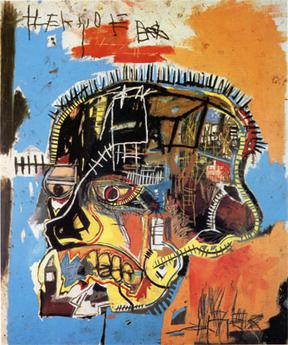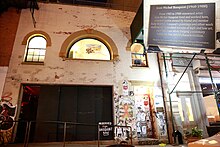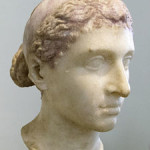 On this day in 30 B.C., the last pharaoh of Ancient Egypt, Cleopatra died, according to tradition, by inducing an Egyptian cobra to bite her, either in her palace in Alexandria or in her tomb, at the age of 39. Born probably in 69 B.C. in Alexandria, Egypt. She was a member of the Ptolemaic dynasty, a family of Greek origin that ruled Ptolemaic Egypt after Alexander the Great’s death during the Hellenistic period. The Ptolemies, throughout their dynasty, spoke Greek and refused to speak Egyptian, which is the reason that Greek as well as Egyptian languages were used on official court documents such as the Rosetta Stone. By contrast, Cleopatra did learn to speak Egyptian and represented herself as the reincarnation of an Egyptian goddess, Isis. Cleopatra originally ruled jointly with her father, Ptolemy XII Auletes, and later with her brothers, Ptolemy XIII and Ptolemy XIV, whom she married as per Egyptian custom, but eventually she became sole ruler. As pharaoh, she consummated a liaison with Julius Caesar that solidified her grip on the throne. She later elevated her son with Caesar, Caesarion, to co-ruler in name. After Caesar’s assassination in 44 BC, she aligned with Mark Antony in opposition to Caesar’s legal heir, Gaius Julius Caesar Octavianus (later known as Augustus). With Antony, she bore the twins Cleopatra Selene II and Alexander Helios, and another son, Ptolemy Philadelphus (her unions with her brothers had produced no children.) After losing the Battle of Actium to Octavian‘s forces, Antony committed suicide. Cleopatra committed suicide nine days after Antony’s death. She was briefly outlived by Caesarion, who was declared pharaoh by his supporters, but soon killed on Octavian’s orders. Egypt became the Roman province of Aegyptus.
On this day in 30 B.C., the last pharaoh of Ancient Egypt, Cleopatra died, according to tradition, by inducing an Egyptian cobra to bite her, either in her palace in Alexandria or in her tomb, at the age of 39. Born probably in 69 B.C. in Alexandria, Egypt. She was a member of the Ptolemaic dynasty, a family of Greek origin that ruled Ptolemaic Egypt after Alexander the Great’s death during the Hellenistic period. The Ptolemies, throughout their dynasty, spoke Greek and refused to speak Egyptian, which is the reason that Greek as well as Egyptian languages were used on official court documents such as the Rosetta Stone. By contrast, Cleopatra did learn to speak Egyptian and represented herself as the reincarnation of an Egyptian goddess, Isis. Cleopatra originally ruled jointly with her father, Ptolemy XII Auletes, and later with her brothers, Ptolemy XIII and Ptolemy XIV, whom she married as per Egyptian custom, but eventually she became sole ruler. As pharaoh, she consummated a liaison with Julius Caesar that solidified her grip on the throne. She later elevated her son with Caesar, Caesarion, to co-ruler in name. After Caesar’s assassination in 44 BC, she aligned with Mark Antony in opposition to Caesar’s legal heir, Gaius Julius Caesar Octavianus (later known as Augustus). With Antony, she bore the twins Cleopatra Selene II and Alexander Helios, and another son, Ptolemy Philadelphus (her unions with her brothers had produced no children.) After losing the Battle of Actium to Octavian‘s forces, Antony committed suicide. Cleopatra committed suicide nine days after Antony’s death. She was briefly outlived by Caesarion, who was declared pharaoh by his supporters, but soon killed on Octavian’s orders. Egypt became the Roman province of Aegyptus.
The Final Footprint – The site of Cleopatra and Antony’s mausoleum is uncertain, though the Egyptian Antiquities Service believes it is in or near the temple of Taposiris Magna, southwest of Alexandria. To this day, Cleopatra remains a popular figure in Western culture. Her legacy survives in numerous works of art and the many dramatizations of her story in literature and other media, including William Shakespeare’s tragedy Antony and Cleopatra, Jules Massenet’s opera Cléopâtre and the 1963 film Cleopatra with Elizabeth Taylor as Cleopatra and Richard Burton as Antony. In most depictions, Cleopatra is portrayed as a great beauty, and her successive conquests of the world’s most powerful men are taken as proof of her aesthetic and sexual appeal.
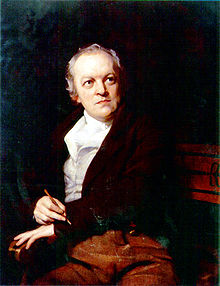 On this day in 1827, painter, poet and printmaker William Blake died at his home in Soho, London at the age of 69. Born on 28 November 1757 at 28 Broad Street (now Broadwick St.) in Soho. Apparently unrecognised during his lifetime, Blake is now considered a seminal figure in the history of the poetry and visual arts of the Romantic Age. It is possible that his prophetic poetry is in proportion to its merits, the least read body of poetry in the English language. His visual artistry is now highly regarded. Blake produced a diverse and symbolically rich oeuvre. Perhaps considered mad by contemporaries for his idiosyncratic views, he is held in high regard by later critics for his expressiveness and creativity, and for the philosophical and mystical undercurrents within his work. His paintings and poetry have been characterised as part of the Romantic movement and “Pre-Romantic”. Reverent of the Bible but hostile to the Church of England (indeed, to all forms of organised religion), Blake appears to have been influenced by the ideals and ambitions of the French and American Revolutions. Blake met Catherine Boucher in 1782 when he was recovering from a relationship that had culminated in a refusal of his marriage proposal. He recounted the story of his heartbreak for Catherine and her parents, after which he asked Catherine, “Do you pity me?” When she responded affirmatively, he declared, “Then I love you.” Blake married Catherine on 18 August 1782 in St Mary’s Church, Battersea. I find most interesting, his critical views of the marriage laws of his day. Blake generally railed against traditional Christian notions of chastity as a virtue. In part due to Catherine’s apparent inability to bear children, he directly advocated bringing a second wife into the house. His poetry suggests that external demands for marital fidelity reduce love to mere duty rather than authentic affection, and decries jealousy and egotism as a motive for marriage laws. Poems such as “Why should I be bound to thee, O my lovely Myrtle-tree?” and “Earth’s Answer” seem to advocate multiple sexual partners. In his poem “London” he speaks of “the Marriage-Hearse” plagued by “the youthful Harlot’s curse”, the result alternately of false Prudence and/or Harlotry. Visions of the Daughters of Albion can be read as a tribute to free love since the relationship between Bromion and Oothoon is held together only by laws and not by love. For Blake, law and love are opposed, and he castigates the “frozen marriage-bed”.
On this day in 1827, painter, poet and printmaker William Blake died at his home in Soho, London at the age of 69. Born on 28 November 1757 at 28 Broad Street (now Broadwick St.) in Soho. Apparently unrecognised during his lifetime, Blake is now considered a seminal figure in the history of the poetry and visual arts of the Romantic Age. It is possible that his prophetic poetry is in proportion to its merits, the least read body of poetry in the English language. His visual artistry is now highly regarded. Blake produced a diverse and symbolically rich oeuvre. Perhaps considered mad by contemporaries for his idiosyncratic views, he is held in high regard by later critics for his expressiveness and creativity, and for the philosophical and mystical undercurrents within his work. His paintings and poetry have been characterised as part of the Romantic movement and “Pre-Romantic”. Reverent of the Bible but hostile to the Church of England (indeed, to all forms of organised religion), Blake appears to have been influenced by the ideals and ambitions of the French and American Revolutions. Blake met Catherine Boucher in 1782 when he was recovering from a relationship that had culminated in a refusal of his marriage proposal. He recounted the story of his heartbreak for Catherine and her parents, after which he asked Catherine, “Do you pity me?” When she responded affirmatively, he declared, “Then I love you.” Blake married Catherine on 18 August 1782 in St Mary’s Church, Battersea. I find most interesting, his critical views of the marriage laws of his day. Blake generally railed against traditional Christian notions of chastity as a virtue. In part due to Catherine’s apparent inability to bear children, he directly advocated bringing a second wife into the house. His poetry suggests that external demands for marital fidelity reduce love to mere duty rather than authentic affection, and decries jealousy and egotism as a motive for marriage laws. Poems such as “Why should I be bound to thee, O my lovely Myrtle-tree?” and “Earth’s Answer” seem to advocate multiple sexual partners. In his poem “London” he speaks of “the Marriage-Hearse” plagued by “the youthful Harlot’s curse”, the result alternately of false Prudence and/or Harlotry. Visions of the Daughters of Albion can be read as a tribute to free love since the relationship between Bromion and Oothoon is held together only by laws and not by love. For Blake, law and love are opposed, and he castigates the “frozen marriage-bed”.
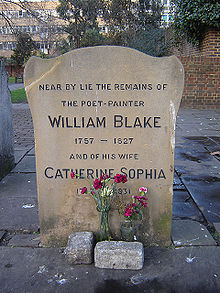 The Final Footprint – On the day of his death, Blake worked relentlessly on his Dante’s Divine Comedy illustration series. Eventually, it is reported, he ceased working and turned to his wife, who was in tears by his bedside. Blake is said to have cried, “Stay Kate! Keep just as you are – I will draw your portrait – for you have ever been an angel to me.” Having completed this portrait (now lost), Blake laid down his tools and began to sing hymns and verses. At six that evening, after promising his wife that he would be with her always, Blake died. A female lodger in the house, present at his expiration, apparently said, “I have been at the death, not of a man, but of a blessed angel.” George Richmond gives the following account of Blake’s death in a letter to Samuel Palmer:
The Final Footprint – On the day of his death, Blake worked relentlessly on his Dante’s Divine Comedy illustration series. Eventually, it is reported, he ceased working and turned to his wife, who was in tears by his bedside. Blake is said to have cried, “Stay Kate! Keep just as you are – I will draw your portrait – for you have ever been an angel to me.” Having completed this portrait (now lost), Blake laid down his tools and began to sing hymns and verses. At six that evening, after promising his wife that he would be with her always, Blake died. A female lodger in the house, present at his expiration, apparently said, “I have been at the death, not of a man, but of a blessed angel.” George Richmond gives the following account of Blake’s death in a letter to Samuel Palmer:
He died … in a most glorious manner. He said He was going to that Country he had all His life wished to see & expressed Himself Happy, hoping for Salvation through Jesus Christ – Just before he died His Countenance became fair. His eyes Brighten’d and he burst out Singing of the things he saw in Heaven.
He was buried five days after his death, on the eve of his 45th wedding anniversary at the Dissenter’s burial ground in Bunhill Fields, where his parents were interred. Catherine believed she was regularly visited by Blake’s spirit. She continued selling his illuminated works and paintings, but entertained no business transaction without first “consulting Mr. Blake”. On the day of her death, in October 1831, she was as calm and cheerful as her husband, and called out to him “as if he were only in the next room, to say she was coming to him, and it would not be long now”. Since 1965, the exact location of William Blake’s grave had been lost as gravestones were taken away to create a lawn. Blake’s grave is commemorated by a stone that reads “Near by lie the remains of the poet-painter William Blake 1757–1827 and his wife Catherine Sophia 1762–1831”. The memorial stone is situated approximately 20 metres away from the actual grave, which is not marked. Members of the group Friends of William Blake have rediscovered the location and intend to place a permanent memorial at the site. Bunhill Fields is a former burial ground in the London Borough of Islington, north of the City of London, now managed as a public garden by the City of London Corporation. It is about 4 hectares (9.9 acres) in extent, although historically it was much larger. It was in use as a burial ground from 1665 until 1854, by which date approximately 123,000 interments were estimated to have taken place. Over 2,000 monuments remain. It was particularly favoured by Nonconformists. Other notable final footprints at Bunhill include; John Bunyan and Daniel Defoe.
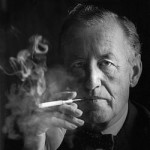 On this day in 1964, English author, journalist and naval intelligence officer, Ian Fleming died at the age of 56 in Canterbury from a heart attack. Born Ian Lancaster Fleming on 28 May 1908 in Mayfair, London. Perhaps best known for his James Bond series of spy novels. Fleming moved through a number of jobs before he started writing. While working for Britain’s Naval Intelligence Division during the Second World War, Fleming was involved in planning Operation Goldeneye and in the planning and oversight of two intelligence units, 30 Assault Unit and T-Force. His wartime service and his career as a journalist provided much of the background, detail and depth of the James Bond novels. Fleming wrote his first Bond novel, Casino Royale, in 1952. Eleven Bond novels and two short-story collections followed between 1953 and 1966. The novels revolve around Bond, an officer in the Secret Intelligence Service, commonly known as MI6. Bond is also known by his code number, 007, and was a commander in the Royal Naval Reserve. The Bond stories rank among the best-selling series of fictional books of all time. He was married to Ann Charteris, who was divorced from the second Viscount Rothermere as a result of her affair with Fleming. Fleming and Charteris had a son, Caspar.
On this day in 1964, English author, journalist and naval intelligence officer, Ian Fleming died at the age of 56 in Canterbury from a heart attack. Born Ian Lancaster Fleming on 28 May 1908 in Mayfair, London. Perhaps best known for his James Bond series of spy novels. Fleming moved through a number of jobs before he started writing. While working for Britain’s Naval Intelligence Division during the Second World War, Fleming was involved in planning Operation Goldeneye and in the planning and oversight of two intelligence units, 30 Assault Unit and T-Force. His wartime service and his career as a journalist provided much of the background, detail and depth of the James Bond novels. Fleming wrote his first Bond novel, Casino Royale, in 1952. Eleven Bond novels and two short-story collections followed between 1953 and 1966. The novels revolve around Bond, an officer in the Secret Intelligence Service, commonly known as MI6. Bond is also known by his code number, 007, and was a commander in the Royal Naval Reserve. The Bond stories rank among the best-selling series of fictional books of all time. He was married to Ann Charteris, who was divorced from the second Viscount Rothermere as a result of her affair with Fleming. Fleming and Charteris had a son, Caspar.
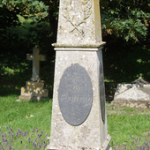 The Final Footprint – Fleming was buried in the churchyard of Sevenhampton village, near Swindon. His last recorded words were an apology to the ambulance drivers for having inconvenienced them, saying “I am sorry to trouble you chaps. I don’t know how you get along so fast with the traffic on the roads these days.” In October 1975, Fleming’s son Caspar, aged 23, committed suicide by drug overdose and was buried with his father. Fleming’s widow, Ann, died in 1981 and was buried with her husband and their son. Bond has appeared in film twenty-five times, to date, and been portrayed by seven actors, including; Sean Connery, George Lazenby, Roger Moore, Timothy Dalton, Pierce Brosnan, and Daniel Craig.
The Final Footprint – Fleming was buried in the churchyard of Sevenhampton village, near Swindon. His last recorded words were an apology to the ambulance drivers for having inconvenienced them, saying “I am sorry to trouble you chaps. I don’t know how you get along so fast with the traffic on the roads these days.” In October 1975, Fleming’s son Caspar, aged 23, committed suicide by drug overdose and was buried with his father. Fleming’s widow, Ann, died in 1981 and was buried with her husband and their son. Bond has appeared in film twenty-five times, to date, and been portrayed by seven actors, including; Sean Connery, George Lazenby, Roger Moore, Timothy Dalton, Pierce Brosnan, and Daniel Craig.
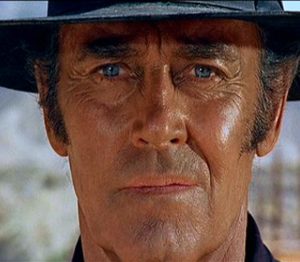 On this day in 1982 U.S Navy veteran, Oscar and Tony winning actor, father of actor Peter Fonda and actress Jane Fonda, grandfather of actress Bridget Fonda, Henry Fonda died at his Los Angeles home from heart disease at the age of 77. Born Henry Jaynes Fonda on 16 May 1905 in Grand Island, Nebraska. My favortie Fonda roles include: as Meredith in A Big Hand for the Little Lady (1966) with Joanne Woodward and Jason Robards; as Frank in Sergio Leone’s Once Upon a Time in the West (C’era una volta il West) (1968) with Charles Bronson, Jason Robards and Claudia Cardinale; as Norman Thayer, Jr. in On Golden Pond (1981) with Katherine Hepburn and Jane Fonda. Fonda was married five times; Margaret Sullavan (1931-1932 divorce), Frances Ford Seymour (1936-1950 her death), Susan Blanchard (1950-1956 divorce), Afdera Franchetti (1957-1961 divorce), and Shirlee Mae Adams (1965-1982 his death).
On this day in 1982 U.S Navy veteran, Oscar and Tony winning actor, father of actor Peter Fonda and actress Jane Fonda, grandfather of actress Bridget Fonda, Henry Fonda died at his Los Angeles home from heart disease at the age of 77. Born Henry Jaynes Fonda on 16 May 1905 in Grand Island, Nebraska. My favortie Fonda roles include: as Meredith in A Big Hand for the Little Lady (1966) with Joanne Woodward and Jason Robards; as Frank in Sergio Leone’s Once Upon a Time in the West (C’era una volta il West) (1968) with Charles Bronson, Jason Robards and Claudia Cardinale; as Norman Thayer, Jr. in On Golden Pond (1981) with Katherine Hepburn and Jane Fonda. Fonda was married five times; Margaret Sullavan (1931-1932 divorce), Frances Ford Seymour (1936-1950 her death), Susan Blanchard (1950-1956 divorce), Afdera Franchetti (1957-1961 divorce), and Shirlee Mae Adams (1965-1982 his death).
The Final Footprint – Fonda was cremated.
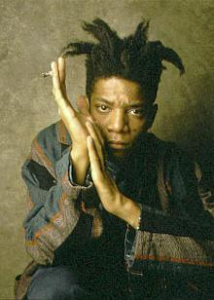 On this day in 1988 artist Jean-Michel Basquiat died of a heroin overdose in his art studio in Manhattan at the age of 27. Born Jean-Michel Basquiat on December 22, 1960 in Brooklyn. Basquiat first achieved fame as part of SAMO, an informal graffiti duo who wrote enigmatic epigrams in the cultural hotbed of the Lower East Side of Manhattan during the late 1970s where the hip hop, punk, and street art cultures had coalesced. By the 1980s, he was exhibiting his neo-expressionist paintings in galleries and museums internationally. The Whitney Museum of American Art held a retrospective of his art in 1992.
On this day in 1988 artist Jean-Michel Basquiat died of a heroin overdose in his art studio in Manhattan at the age of 27. Born Jean-Michel Basquiat on December 22, 1960 in Brooklyn. Basquiat first achieved fame as part of SAMO, an informal graffiti duo who wrote enigmatic epigrams in the cultural hotbed of the Lower East Side of Manhattan during the late 1970s where the hip hop, punk, and street art cultures had coalesced. By the 1980s, he was exhibiting his neo-expressionist paintings in galleries and museums internationally. The Whitney Museum of American Art held a retrospective of his art in 1992.
Basquiat’s art focused on “suggestive dichotomies”, such as wealth versus poverty, integration versus segregation, and inner versus outer experience. He appropriated poetry, drawing, and painting, and married text and image, abstraction, figuration, and historical information mixed with contemporary critique.
Basquiat used social commentary in his paintings as well as attacks on power structures and systems of racism, while his poetics were acutely political and direct in their criticism of colonialism and support for class struggle.
The Final Footprint
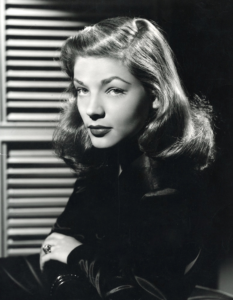 On this day in 2014, actress and singer Lauren Bacall (born Betty Joan Perske in The Bronx, September 16, 1924) died at her apartment in The Dakota, the Upper West Side building overlooking Central Park in Manhattan, at the age of 89 from a stroke. She received an Academy Honorary Award from the Academy of Motion Picture Arts and Sciences in 2009, “in recognition of her central place in the Golden Age of motion pictures.”
On this day in 2014, actress and singer Lauren Bacall (born Betty Joan Perske in The Bronx, September 16, 1924) died at her apartment in The Dakota, the Upper West Side building overlooking Central Park in Manhattan, at the age of 89 from a stroke. She received an Academy Honorary Award from the Academy of Motion Picture Arts and Sciences in 2009, “in recognition of her central place in the Golden Age of motion pictures.”Bacall began her career as a model, before making her debut as a leading lady with Humphrey Bogart in the film To Have and Have Not in 1944. She continued in the film noir genre with appearances with Bogart in The Big Sleep (1946), Dark Passage (1947), and Key Largo (1948), and starred in the romantic comedies How to Marry a Millionaire (1953) with Marilyn Monroe and Designing Woman (1957) with Gregory Peck. She co-starred with John Wayne in his final film, The Shootist (1976). Bacall also worked on Broadway in musicals, earning Tony Awards for Applause (1970) and Woman of the Year (1981). Her performance in The Mirror Has Two Faces (1996) earned her a Golden Globe Award and an Academy Award nomination.
On May 21, 1945, Bacall married actor Humphrey Bogart, 25 years her senior. Their wedding and honeymoon took place at Malabar Farm, Lucas, Ohio, the country home of Pulitzer Prize-winning author Louis Bromfield, a close friend of Bogart. The wedding was held in the Big House. They remained married until Bogart’s death from esophageal cancer in 1957. Pressed by an interviewer to talk about her marriage to Bogart, and asked about her notable reluctance to do so, she replied that “being a widow is not a profession”.
On July 4, 1961, Bacall married Jason Robards in Ensenada, Mexico. The couple divorced in 1969.
The Final Footprint – Cremation. Cremated remains at Forest Lawn Memorial Park Glendale. Other notable Final Footprints at Forest Lawn Glendale include; L. Frank Baum, Humphrey Bogart, Lon Chaney, Nat King Cole, Sam Cooke, Dorothy Dandridge, Sammy Davis, Jr., Walt Disney, Errol Flynn, Clark Gable, Jean Harlow, Michael Jackson, Carole Lombard, Tom Mix, Casey Stengel, Jimmy Stewart, Elizabeth Taylor, and Spencer Tracy.
Have you planned yours yet?
Follow TFF on twitter @RIPTFF


